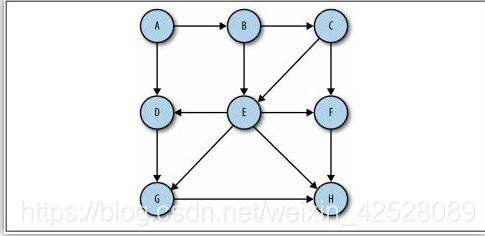bfs算法,宽度优先搜索算法。

def bfs(graph,start):
queue,visited = [start],[start]
while queue:
vertex=queue.pop()
for i in graph[vertex]:
if i not in visited:
visited.append(i)
queue.append(i)
return visited
G={"A":{"B","D"},
"B":{"C","E"},
"C":{"E","F"},
"D":{"G"},
"E":{"D","F","G","H"},
"F":{"H"},
"G":{"H"},
"H":{}}
print(bfs(G,'A' ))【'A', 'B', 'D', 'E', 'C', 'G', 'H', 'F'】
DFS算法:深度优先搜索算法
def dfs(graph,vertex,queue=[]):
queue.append(vertex)
for i in graph[vertex]:
if i not in queue:
queue=dfs(graph,i,queue)
return queue
graph = { 1: [ 2, 3 ], 2: [ 4, 5 ],
3: [ 5 ], 4: [ 6 ], 5: [ 6 ],
6: [ 7 ], 7: [] }
print(dfs(graph,1,))
运行结果[1, 2, 3, 4, 5, 6, 7]
dijkstra 算法:求访问完所有节点的最短路径
G = {1: {2: 5, 4: 2, 5: 7},
2: {3: 4},
3: {},
4: {2: 1, 3: 10},
5: {3: 3}}
def dijkstra(graph,source):
visited =set()
distance = dict((k ,float("inf")) for k in G.keys())
distance[source]=0
while len(G)!=len(visited):
visited.add(source)
for next_node in graph[source]:
if distance[next_node]>distance[source]+graph[source][next_node]:
distance[next_node]=distance[source]+graph[source][next_node]
INF=float("inf")
for node in distance.keys():
if node not in visited and distance[node]< INF:
INF,source= distance[node],node
return distance
distance = dijkstra(G, 1)
print(distance)
运行结果:
{1: 0, 2: 3, 3: 7, 4: 2, 5: 7}